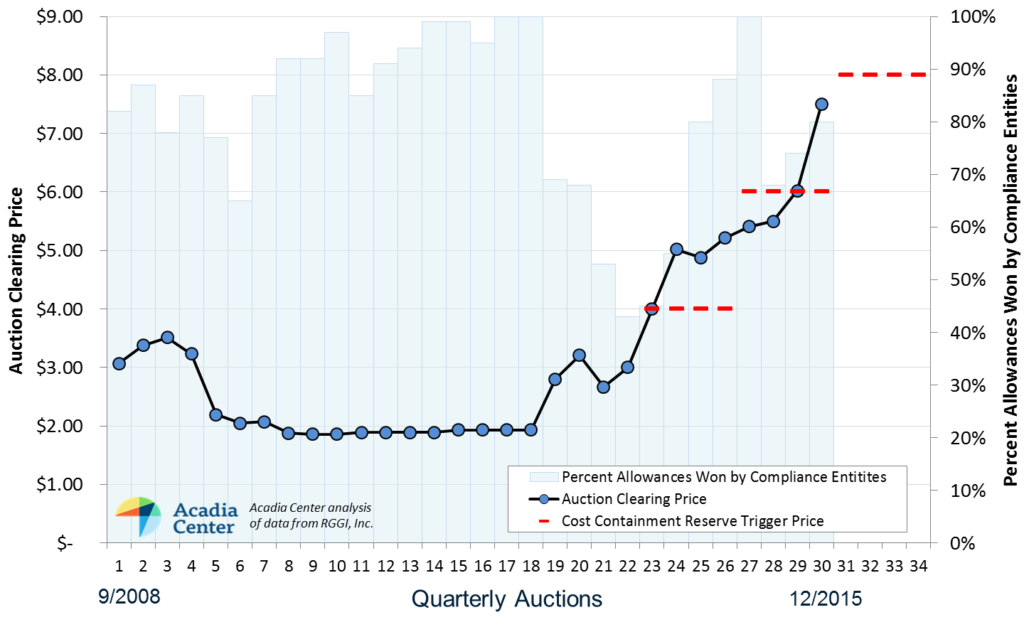New Hampshire Has the Opportunity to Improve Low Energy Efficiency Ranking
Expanding energy efficiency for electric and natural gas customers will deliver multiple benefits to New Hampshire. For customers, efficiency investments lower utility bills now and in the future, improve comfort, health and safety, and provide them with more control and understanding of their energy use. For the electric grid, efficiency increases reliability and decreases outages, and delays or avoids the need to spend significant funds on new capacity. For the local economy, these investments create local jobs, give businesses a competitive edge, and lower energy prices for all. And for the environment, efficiency reduces air pollution, water use and greenhouse gas emissions.
Indeed, energy efficiency is the cheapest, cleanest, most plentiful energy resource in the state.Investing in energy efficiency saves money in the long-term, but there are many market barriers which prevent consumers from doing it on their own. While New Hampshire’s utility-run efficiency programs have provided a host of benefits to residents, it is falling increasingly behind it neighbors. New Hampshire ranked #20 on the 2015 State Energy Efficiency Scorecard, released October 22nd by the American Council for an Energy-Efficient Economy (ACEEE), a national nonpartisan organization. While the state is up two places since last year, it still ranks well below its neighbors in New England – Massachusetts (#1), Vermont (#3), Rhode Island, (#4) Connecticut (#6), and Maine (#14).
So where can New Hampshire begin to gain ground and reap increased benefits from investing in efficiency? Here are two suggestions for (nearly) immediate gains:
Energy Efficiency Resource Standard
Currently New Hampshire is the only state in New England without a formal efficiency savings goal, which is one key reason why the state’s efficiency savings are well below its neighbors. The Public Utilities Commission is currently undergoing a process to establish an Energy Efficiency Resource Standard (EERS) in the state. Utilities and other stakeholders have filed proposals this month for how such a standard might be structured and funded, with the goal of finalizing it this spring. The PUC is on the right track, but for the EERS to prove successful it must contain a clear and ambitious goal for energy savings to ensure all New Hampshire residents get adequate help in reducing their energy use.
Building Energy Codes
Putting in place modern building energy codes is crucial because it ensures that new buildings start off highly efficient. It is a lot easier to build efficient buildings than to retrofit inefficient ones down the road. New Hampshire adopted the 2009 International Energy Conservation Code (IECC), a leading model energy code for new residential and commercial construction. Unfortunately it did not implement them in 2012, as most leading states did. If the 2012 IECC were already in place, it would not only have earned a full point under ACEEE’s scoring, but also would have locked in major energy savings as all new construction would have had to comply with this more stringent code level for the last three years. The New Hampshire Building Code Review Board is in the process of reviewing the 2015 IECC, and has held a public hearing. If accepted, the amendments would be effective for a maximum of two years unless ratified by the legislature.
Making smart decisions now will help New Hampshire keep more money in the state and in the pockets of its residents.

Ellen Hawes is a senior analyst at Acadia Center focusing on energy systems, land use and carbon markets. She also leads Acadia Center’s participation in the New Hampshire State Energy Strategy process. Ellen received her Master in Forestry from the Yale School of Forestry and Environmental Studies.
Acadia Center’s November/December Newsletter
A look at Acadia Center’s work in November and December. This newsletter highlights the release of our new report Community|EnergyVision, staff participation in our Giving Tuesday Campaign, and a report from the Massachusetts’ Attorney General’s office stating that new publicly-funded natural gas pipelines are unnecessary.
Electric Cars Await Jump-start in New Jersey
…There are about 2,500 electric vehicles in New Jersey among the 5.7 million registered vehicles in the state. New Jersey trails New York, which has 12,000, Massachusetts, with 5,500, Maryland, with 5,000 and Connecticut, 3,000, according to a study by the environmental advocacy groups Conservation Law Foundation, the Sierra Club and Acadia Center…
RI Public Utilities Commission Votes to Eliminate Energy Waste in 2016
PROVIDENCE, RI – On December 16, 2015 the Rhode Island Public Utilities Commission unanimously approved the 2016 Energy Efficiency Plan for Rhode Island in order to help save consumers money on their utility bills and boost Rhode Island’s economy. This plan was developed collaboratively by key stakeholders representing a wide range of consumer interests, including the Division of Public Utilities and Carriers, the Office of Energy Resources, the Energy Efficiency and Resource Management Council, Acadia Center, People’s Power and Light, and Green and Healthy Homes.
In 2006, Rhode Island adopted the strategic and economic approach of investing in low cost energy efficiency in order to reduce consumers’ energy costs. In 2016, electricity from power plants like the Manchester Street Station in Providence will cost about 12 cents per kilowatt-hour, while the cost of eliminating wasted energy through efficiency improvements is about 5 cents per kilowatt-hour.
“Energy efficiency is an energy resource just like power from the coal and natural gas-fired power plants at Salem Harbor, Brayton Point, and Manchester Street. But energy efficiency is much cheaper, cleaner, and lower risk. In fact, the Public Utilities Commission’s decision to approve this plan is the best way to help customers save money,” said Acadia Center Rhode Island Director Abigail Anthony. Dr. Anthony represents environmental interests on the state’s Energy Efficiency and Resource Management Council (EERMC), which provides independent input and oversight to National Grid’s electric and natural gas efficiency programs.
Rhode Island’s energy efficiency programs help residents and businesses make energy efficient decisions by providing technical assistance and information coupled with financial incentives. For example, a residential electric or natural gas customer is eligible to receive a free home energy assessment during which the auditor will evaluate the lighting, insulation, appliance efficiency, and overall energy “fitness” of the home. The auditor will also inform the customer if she is eligible for financial incentives to help reduce the out-of-pocket cost of investing in energy efficient improvements, such as weatherization or new heating equipment. Loans are available to help homeowners and business owners with the up-front costs of efficiency upgrades.
These programs are proven and work for Rhode Island. The American Council for an Energy Efficient Economy has ranked Rhode Island in the top 5 states for energy efficient programs for the past 3 years. In addition to helping Rhode Islanders lower their utility bills, the state’s investments in low cost energy efficiency reduce the cost of doing business in the state, create jobs, and boost economic activity. The avoided spending on electricity and natural gas from the 2016 Energy Efficiency Plan will generate $265 million in economic benefits to Rhode Islanders and add $386 million to Gross State Product. Rhode Island’s energy efficiency programs directly support 639 jobs across 899 firms, more than 70 percent of which are located in Rhode Island.
In 2014, The Division of Public Utilities–the state agency charged with watching out for consumer interests– commissioned the research firm Synapse Energy Economics to see what efficiency is really doing for our electric bills. The analysis finds that a Rhode Island homeowner who gets a home energy assessment can save approximately 12% on her electric bill by replacing inefficient lighting and appliances and upgrading home insulation and weatherization. Factor in savings on natural gas or fuel oil use and total spending on energy is even lower. And small business customers, who are eligible for free energy audits, can save as much as 37% to 47% by installing high efficiency equipment and making recommended retrofits.
Contact:
Abigail Anthony, Rhode Island Director
401-474-8876, aanthony@acadiacenter.org
Kiernan Dunlop, Communications Associate
617-742-0054 x107, kdunlop@acadiacenter.org
###
Acadia Center is a non-profit, research and advocacy organization committed to advancing the clean energy future. Acadia Center is at the forefront of efforts to build clean, low-carbon and consumer-friendly economies. Acadia Center provides accurate and reliable information, and offers a real-world and comprehensive approach to problem solving through innovation and collaboration.
Remaking Connecticut’s Energy System to Embrace Community Energy
As we head into another winter that could once again hit Connecticut residents and communities with high energy costs, the urgency to remake our energy system only increases. With emerging technologies and approaches, a new and better system is possible.
To become a reality, though, this better energy system will need to empower communities with innovative, on-the-ground energy solutions. So, how do we make sure that the current clean energy revolution puts Connecticut’s communities at its center?
Acadia Center’s event next Wednesday, December 16th, “Remaking Connecticut’s Energy System to Embrace Community Energy” will explore that question.
The gathering will feature an expert discussion on how communities can take control of their energy costs and needs through new approaches and policy innovations. Our panelists will be:
Scudder Parker, Senior Policy Advisor, Vermont Energy Investment Corporation
Jonathan Glass, President & Co-Founder, Wise Labs
Jamie Howland, Director, Energy Efficiency and Demand-Side Initiative, Acadia Center
Select topics will include: creating a sustainable energy utility to better serve community energy needs, exploring the community benefits offered by smart LED streetlights, and identifying notable community energy trends and developments in Connecticut and beyond.
We will also be releasing our new report, Community EnergyVision, which identifies four key areas of reform needed to spur the growth of local, clean energy resources. Community EnergyVision also identifies exemplary projects, practices, and innovations that should be replicated in Connecticut.
This discussion will be followed by breakout groups of attendees to further explore specific issues in depth. We hope you’ll join us.
When
Wednesday, December 16 10:30 AM – 12:30 PM
Where
New Haven Free Public Library
133 Elm Street
New Haven, CT 06510
We encourage you to use public transportation, but metered street parking and parking garages are available.
Parking Garages within a half mile of the event:
Grove Street Garage, 65 Grove Street
State Street Garage, 290 State Street
RSVP
If you plan to come, please register in advance on our Eventbrite page because space is limited. The event is free and all are welcome to attend.

Bill Dornbos is the Director of the Connecticut Office and Senior Attorney for Acadia Center. Bill focuses on advancing policy and regulatory solutions that seek to transform the energy system and move Connecticut towards a climate-safe, sustainable future. Recent work includes advocating for expanded investment in cost-effective energy efficiency for all fuels and analyzing greenhouse gas emissions trends in the Northeast
RGGI Prices Rise as Emissions Continue to Fall
Results released today from RGGI’s 30th auction evidence the program’s continuing success, while also highlighting reforms needed to maximize environmental performance. All available allowances were sold at a clearing price of $7.50, 24% higher than the previous auction, and 44% higher than the clearing price from one year ago. The RGGI states raised $436 million dollars from the four auctions in 2015, and have now raised $2.37 billion for reinvestment since the program began, the majority of which has been used to fund energy efficiency and other consumer benefit programs. RGGI has been a successful model for reducing power sector emissions, and with reforms to ensure future environmental performance, it will be an effective means of complying with EPA’s Clean Power Plan.
The results of this latest auction show that the RGGI market continues to thrive while sending an increasingly significant price signal to the electric sector in favor of carbon-free resources. These rising prices serve as a vote of confidence in RGGI’s future as states begin a comprehensive review of the program. “The 2016 Program Review is a crucial opportunity for the RGGI states to continue to lead by example,” said Acadia Center President, Daniel Sosland. “The efforts of the RGGI states to review and improve the program have resulted in a model system for cost-effective carbon reduction that serves as a blueprint for states across the country.”
While today’s auction results demonstrate the RGGI model’s ability to drive real change in the energy sector, they also highlight one important change that will be necessary as part of this program review. The Cost Containment Reserve (CCR), which releases additional allowances when price triggers are met, will need to be reformed. As the graph below shows, price triggers have been exceed in both of the CCR’s first two years of operation, and the RGGI market appears poised to exceed the $8/ton price threshold in 2016.
“The CCR is intended to mitigate price volatility by releasing an additional supply of allowances if increases in emissions create allowance shortages,” said Jordan Stutt, Policy Analyst with Acadia Center. “However, the CCR has been exhausted in both 2014 and 2015 even as emissions are trending downward, undermining progress towards emissions reductions in the power sector.” Emissions for 2015 are on trend to total 86 million tons, assuming fourth quarter emissions are similar to last year. Even with emissions below the cap in the last two years, 15 million additional allowances have been released by the CCR, and the current structure would allow for 65 million additional tons of CO2 emissions through 2020. To solve this problem, the CCR will have to either be eliminated, or restructured with higher trigger prices and allowances that are drawn from beneath the cap.
Stakeholders in the RGGI states will be submitting comments to RGGI, Inc. today to describe how the program could be strengthened, and how the RGGI states can continue their climate leadership under EPA’s Clean Power Plan. The comments will focus on the need to meet existing state climate goals, threshold considerations for expanding RGGI to other states, and technical fixes like reform of the CCR.
“As world leaders gather in Paris to discuss solutions to one of the planet’s greatest challenges, they can point to RGGI as a shining example of market-driven policy,” said Peter Shattuck, Director of Acadia Center’s Clean Energy Initiative. “The program’s success to-date has been proven; it’s now up to the RGGI states to signal their ambitions for the future.”
Additional information on RGGI’s performance to date, and role in EPA’s regulatory process are described in Acadia Center’s July, 2015 report: RGGI: A Model Program for the Power Sector
RGGI Overview:
The Regional Greenhouse Gas Initiative (RGGI) is the first mandatory, market-based effort in the United States to reduce greenhouse gas emissions. Nine Northeastern and Mid-Atlantic states reduce CO2 emissions by setting an overall limit on emissions “allowances” which permit power plants to dispose of CO2 in the atmosphere. States sell allowances through auctions and invest proceeds in consumer benefit programs: energy efficiency, renewable energy, and other programs.
The official RGGI web site is: www.rggi.org
Contact:
Jordan Stutt, Policy Analyst
jstutt@acadiacenter.org, (617) 742-0054 x105
Kiernan Dunlop, Communications Associate
kdunlop@acadiacenter.org, (617) 742- 0054 x107
###
Acadia Center is a non-profit, research and advocacy organization committed to advancing the clean energy future. Acadia Center is at the forefront of efforts to build clean, low-carbon and consumer-friendly economies. Acadia Center provides accurate and reliable information, and offers a real-world and comprehensive approach to problem solving through innovation and collaboration.
Home Business Electric Supplies Adequate for Winter, but Natural Gas Infrastructure Could Pose Challenge to Reliable Operation, ISO-NE Says
…Peter Shattuck, Massachusetts director for Acadia Center, a Boston-based group that promotes clean energy efforts, said given what power usage data is showing around the region, it would be foolhardy to undertake a full-scale expansion of natural gas transmission pipelines. “There could be benefits to building natural gas pipelines, but there could be cheaper, quicker alternatives,” Shattuck said. “Demand is coming down and we’re seeing power plants install backup generation capability. We should be taking a few years to find out what is the lowest risk, most affordable solution…”
Massachusetts Would Set Highest Energy Savings Goals in the Nation with 2016-2018 Energy Efficiency Plan
Boston, MA– Massachusetts’ utilities have proposed the nation’s most ambitious energy efficiency programs, which will produce almost $8 billion in benefits over the next three years. The next chapter of the award-winning MassSave energy efficiency programs is now in the hands of the Department of Public Utilities, with a decision on the final proposed 2016-2018 Energy Efficiency Investment Plans expected by the end of January. Public comment on the plans is being heard today, November 30, 2015, beginning at 2 PM at the DPU’s offices at One South Station, 5th Floor.
The proposed plan features goals and strategies for saving energy and reducing bills for Massachusetts homes and businesses. If adopted, the programs will provide almost $8 billion in economic benefits and energy savings over the three year period – on top of $12.5 billion in benefits that the programs have delivered since 2008. The plan also sets the highest savings goals in the nation – annual reductions of 2.93% of electric retail sales and 1.24% of natural gas retail sales – even higher than the 2015 savings goals that resulted in Massachusetts being ranked #1 in energy efficiency by the American Council for an Energy Efficient Economy for the 5th year running. Energy savings would deliver environmental benefits equivalent to removing over 410,000 cars from the road.
“Massachusetts’ energy efficiency programs are delivering on their promise to create large energy savings for consumers, and move the Commonwealth toward a clean, affordable and secure energy future,” said Daniel L. Sosland, Acadia Center President. “Efficiency is the best near-term energy strategy for reducing Massachusetts’ residents’ energy bills. Investing in energy efficiency produces immediate bill savings that persist for years to come,” said Sosland.
The three-year plan was developed collaboratively with the state’s utilities and key stakeholders representing a wide range of consumer and environmental interests, including Acadia Center, the Energy Efficiency Advisory Council (EEAC), the Department of Energy Resources, and the Attorney General’s Office. By making successful use of the EEAC as a stakeholder council, the proposed plan improved markedly since the original draft in April. Among other factors, annual electric savings goals increased 17%, while the cost per unit of savings decreased 13%; and annual gas savings goals increased 15% while the cost per unit of savings decreased 6%, compared to the April 30th draft.
“Energy efficiency is a resource just like energy from Brayton Point, Pilgrim Nuclear, or other centralized power plants” said Acadia Center Senior Attorney, and EEAC representative, Amy Boyd. “But energy efficiency is much cheaper, cleaner, and lower risk. Approving this plan would be the best way to help customers save money.”
By investing in as much low-cost energy efficiency as possible, Massachusetts is reducing the cost of doing business in the state and leaving consumers with more money in their pockets. Such consumer savings are often spent right in Massachusetts —where they can support our local markets, our students, our education and health facilities—while payments to fossil fuel providers head immediately out of state. Every dollar invested in cost-effective energy efficiency boosts the Massachusetts Gross State Product an estimated $6.40 and every $1 million invested in energy efficiency generates around 43 job-years of employment.
Contact:
Amy Boyd, Senior Attorney
aboyd@acadiacenter.org , (617) 742-0054 x102
Kiernan Dunlop, Communications Associate
kdunlop@acadiacenter.org, (617) 742- 0054 x107
###
Acadia Center is a non-profit, research and advocacy organization committed to advancing the clean energy future. Acadia Center is at the forefront of efforts to build clean, low-carbon and consumer-friendly economies. Acadia Center provides accurate and reliable information, and offers a real-world and comprehensive approach to problem solving through innovation and collaboration.
We Are Not Facing an Energy Crisis, Here Are Four Reasons Why
The Massachusetts Attorney General’s Office recently released a study showing that energy efficiency and demand response are more cost-effective than publicly-funded pipelines in meeting the region’s energy needs, and that renewable energy will help us achieve greenhouse gas reduction goals. Four key facts support the study’s findings:
- Electricity prices have declined without new pipelines: Massachusetts’ electricity prices are declining due to improved planning and market reforms. Specifically, Eversource’s winter rate is 27% lower than last year’s rate, and National Grid’s rate is almost 25% lower than last year. These lower prices are due in part to market reforms, implemented by the regional grid operator ISO-New England, that are improving utilization of existing gas delivery infrastructure and leading power generators to develop plans for ensuring adequate fuel supplies during winter peak.
- Energy efficiency is reducing electricity demand: Massachusetts’ and other New England states’ aggressive energy efficiency programs are causing winter energy demand to decline, reducing the need for additional pipeline capacity and other energy infrastructure. Despite using conservative assumptions that overstate the cost and understate the impact of efficiency programs, ISO-NE predicts that winter peak demand will decline by 0.1% annually through 2024, and the actual impact of energy efficiency is likely far greater. Acadia Center has demonstrated that ISO-NE consistently overestimates energy consumption and peak demand: winter peak energy demand was 24% lower in 2014 than the 2006 projection, and total 2014 energy consumption was 17% lower than the 2006 projection. These inaccurate projections overstate the need for expensive energy infrastructure, including oversized natural gas pipelines that could be used to support gas exports overseas the majority of the year.
- Clean energy procurement will displace gas generation: On November 12th Massachusetts, Connecticut and Rhode Island released a Request for Proposals (RFP) for significant quantities (up to 1,000MW plus) of hydroelectric and wind, and solar energy that will displace natural gas generation and reduce power sector natural gas demand. Legislative proposals in Massachusetts to procure additional hydroelectricity and wind could more than double the quantity of energy in the RFP, offsetting even more natural gas demand. It is worth noting that the costs for hydroelectricity, renewable energy, and transmission are conservatively overstated in the Attorney General’s report, and actual prices for blended wind and hydroelectricity would have to be lower to compete in the regional electricity market.
- Gas plants with limited backup generation: New power plants approved through the regional grid operator’s Forward Capacity Market Auction in early 2015 all include natural gas generation with oil backup. On the few coldest days when natural gas supplies are dedicated to meeting heating needs, these plants will run on oil. This modest, limited use of oil generation during winter peaks in the near term, before more renewable generation comes online, would have a far smaller impact on GHG emissions than new pipelines used year-round, and would be less expensive to consumers than pipeline expansion.
The Attorney General’s report shows that commonsense market reforms, improvements in energy efficiency, and new clean energy supplies offer the best pathway to addressing winter price volatility, and achieve necessary GHG reductions, and the findings are matched by facts on the ground.

Peter Shattuck is Director of Acadia Center’s Massachusetts office and Clean Energy Initiative. Peter’s work at Acadia Center focuses on cleaning up the energy supply across all sectors of the economy. Driving market-based emissions reductions is at the core of this work, using cap and trade policies such as the Regional Greenhouse Gas Initiative, which Acadia Center has tracked since the program’s early development in the 2000s.
Giving Solar Consumers the Cold Shoulder
…As the article describes, many business groups argue that lifting the caps would result in hundreds of millions of dollars more in consumer electric bills. These numbers, however, are off-base as shown by studies done by Environment Massachusetts and the Acadia Center, among others. In fact, lifting net-metering caps will result in a net social gain…




















